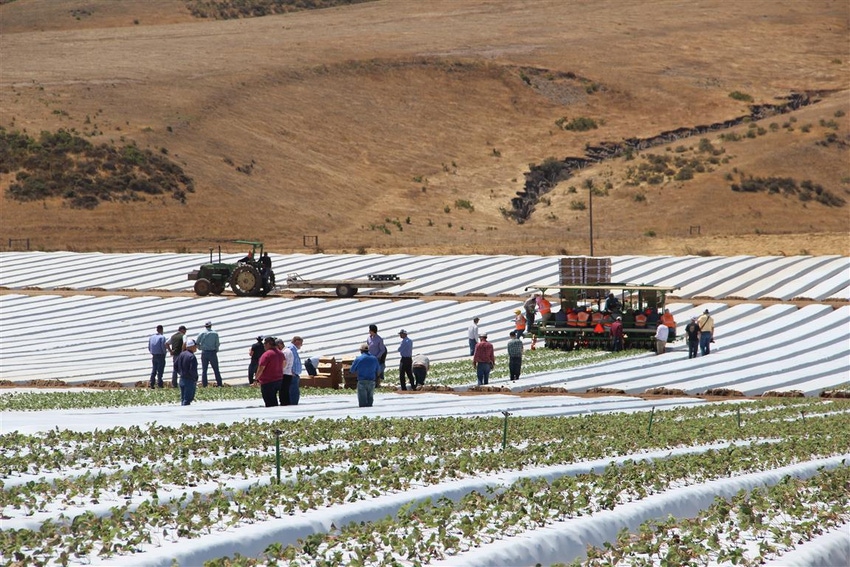August 15, 2016

The availability and cost of hand labor in strawberries, as with other crops, is forcing an evolution of mechanization. One large company says they've significantly sped up the transplanting process while greatly reducing man hours.
For strawberry growers faced with the necessity of manual labor for planting, tending plants, processing of transplants or harvesting fruits, the shortage of skilled farm workers is a major challenge.
Summer planting schedule issues are further exacerbated by the need for laborers to harvest the previous year’s fall plantings.
Driscoll’s, the largest berry producer in the world, developed a mechanical strawberry transplanting machine that hopes to at least make the planting process more streamlined and less labor intensive.
Last June, the Driscoll’s team demonstrated its 3-bed transplanter to growers in an organic strawberry field in the Santa Maria, Calif. area.
Chris Jenkins, product specialist at Driscoll’s, conceived the idea and worked with Chris Waldron at Plantel Nurseries and Matt Phillips at Solex to develope the first mechanical strawberry transplanter. Tim McDonald at Guadalupe Hardware also helped in this development.
They first experimented with their 1-bed transplanter in February, using celery transplants grown to represent the strawberry transplants.
In the meantime, they developed a 3-bed transplanter that was later used to plant 10 acres of strawberries.
“We took the Italian machine used for transplanting peppers and other crops in mulch and modified it for strawberries,” said Waldron. “It costs about $46,000 for the transplanter units that cover three beds. With the tractor, racks, seating, and other equipment, the total cost could be about $120,000 for the entire unit.”
Under typical conditions, 10 farm workers, including a plant distributor, forklift driver and a crew boss are required. A crew this size can work eight hours to transplant one acre of strawberries in a 28,000-plant, four-row configuration.
The mechanical transplanter can plant 10 acres in a day with the help of a 19-member crew, which includes the tractor driver, a plant handler/loader, 12 planters (one per each plant line loading the transplants into the planting slots), and five people checking the transplanted plants on the bed.
It used to take 100 people to manually transplant 10 acres.
“Harvesting crew members get about $30/hour and putting them on a transplanting job with about $10/hour is not ideal,” says Jenkins. “With the help of this machine, we can now engage the farm workers in a high paying job. As the transplanter does most of the work, it will allow the available labor to focus on harvesting fresh market strawberries that fetch a higher price than processing strawberries.”
Some of the advantages of the mechanical transplanter include:
Efficient and uniform transplanting that requires less time and manpower;
Avoidance of human errors in planting depth, j-roots, and other such issues in manual planting of bare root transplants;
Misted tip transplants actively growing and are not dormant like bare root transplants. They are also in an advanced growth stage compared to bare root transplants and will likely start fruit production 2-3 weeks earlier than the latter;
Once separated from the mother plants, it takes about six weeks for the misted tip transplants, while several months of field production and refrigeration are required for bare root transplants;
Local production of misted tip transplants is more likely to adjust to grower needs and probably has a better control over producing uniform and good quality transplants that can be easily supplied without long distance transportation; and,
It is less likely to have soil borne diseases from misted tip transplants compared to the bare root transplants from a traditional infield nursery.
Fruit yields from misted tip transplants were nearly double as the yields from bare root plants in the 2015 study conducted by Driscoll’s. Uniform planting, better plant health, and early fruit production could have contributed to higher yields from the misted tip plants.
For the latest on western agriculture, please check out Western Farm Press Daily and receive the latest news right to your inbox.
You May Also Like




